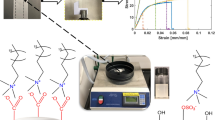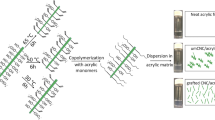Abstract
In this study, surface-initiated ring-opening polymerization has been employed for the grafting of ε-caprolactone from cellulose nanoparticles, made by partial hydrolysis of cellulose cotton linters. A sacrificial initiator was employed during the grafting reactions, to form free polymer in parallel to the grafting reaction. The degree of polymerization of the polymer grafts, and of the free polymer, was varied by varying the reaction time. The aim of this study was to estimate the cellulose nanoparticle degree of surface substitution at different reaction times. This was accomplished by combining measurement results from spectroscopy and chromatography. The prepared cellulose nanoparticles were shown to have 3.1 (±0.3) % of the total anhydroglucose unit content present at the cellulose nanoparticle surfaces. This effectively limits the amount of cellulose that can be targeted by the SI-ROP reactions. For a certain SI-ROP reaction time, it was assumed that the resulting degree of polymerization (DP) of the grafts and the DP of the free polymer were equal. Based on this assumption it was shown that the cellulose nanoparticle surface degree of substitution remained approximately constant (3–7 %) and seemingly independent of SI-ROP reaction time. We believe this work to be an important step towards a deeper understanding of the processes and properties controlling SI-ROP reactions occurring at cellulose surfaces.






Similar content being viewed by others
Abbreviations
- FRP:
-
Free radical polymerization
- RDRP:
-
Reversible-deactivation radical polymerization
- Ð M :
-
Molar-mass dispersity
- ATRP:
-
Atom transfer radical polymerization
- RAFT:
-
Reversible addition-fragmentation chain-transfer
- NMP:
-
Nitroxide-mediated polymerization
- ROP:
-
Ring-opening polymerization
- SI-ROP:
-
Surface-initiated ring-opening polymerization
- AGU:
-
Anhydroglucose unit
- CNF:
-
Cellulose nanofibrils
- CNC:
-
Cellulose nanocrystals
- Sn(Oct)2 :
-
Tin 2-ethylhexanoate
- PCL:
-
Poly(ε-caprolactone)
- ε-CL:
-
ε-Caprolactone
- CCL:
-
Cellulose cotton linters
- HCCL:
-
Hydrolyzed cellulose cotton linters
- CP/MAS:
-
Cross-polarization/magic angle spinning
- DSBM :
-
Bulk monomer degree of substitution
- PCL-g-HCCL:
-
PCL-grafted HCCL
- DP:
-
Degree of polymerization
- SEC:
-
Size exclusion chromatography
- DSSP :
-
Degree of polymer/cellulose nanoparticle surface substitution
- NaClO4 :
-
Sodium perchlorate
- BnOH:
-
Benzyl alcohol
- THF:
-
Tetrahydrofuran
- MeOH:
-
Methanol
References
Biela T, Duda A, Penczek S (2002) Control of Mn, Mw/Mn, end-groups, and kinetics in living polymerization of cyclic esters. Macromol Symp 183(1):1–10. doi:10.1002/1521-3900(200207)183:1<1::aid-masy1>3.0.co;2-q
Boujemaoui A, Carlsson L, Malmström E, Lahcini M, Berglund L, Sehaqui H, Carlmark A (2012) Facile preparation route for nanostructured composites: surface-Initiated ring-opening polymerization of ε-caprolactone from high-surface-area nanopaper. ACS Appl Mater Interfaces 4(6):3191–3198. doi:10.1021/am300537h
Braunecker WA, Matyjaszewski K (2007) Controlled/living radical polymerization: features, developments, and perspectives. Prog Polym Sci 32:93–146. doi:10.1016/j.progpolymsci.2006.11.002
Carlmark A (2013) Tailoring cellulose surfaces by controlled polymerization methods. Macromol Chem Phys 214(14):1539–1544. doi:10.1002/macp.201300272
Carlmark A, Malmström E (2002) Atom transfer radical polymerization from cellulose fibers at ambient temperature. J Am Chem Soc 124(6):900–901. doi:10.1021/ja016582h
Carlmark A, Larsson E, Malmström E (2012) Grafting of cellulose by ring-opening polymerisation—a review. Eur Polym J 48(10):1646–1659. doi:10.1016/j.eurpolymj.2012.06.013
Carlsson L, Utsel S, Wågberg L, Malmström E, Carlmark A (2012) Surface-initiated ring-opening polymerization from cellulose model surfaces monitored by a Quartz Crystal Microbalance. Soft Matter 8(2):512–517. doi:10.1039/c1sm06121f
Carothers WH, Dorough GL, van Natta FJ (1932) Studies of polymerization and ring formation. X. The reversible polymerization of six-membered cyclic esters. J Am Chem Soc 54(2):761–772. doi:10.1021/ja01341a046
Chunilall V, Bush T, Larsson PT, Iversen T, Kindness A (2010) A CP/MAS 13C-NMR study of cellulose fibril aggregation in eucalyptus dissolving pulps during drying and the correlation between aggregate dimensions and chemical reactivity. Holzforschung 64(6):693–698. doi:10.1515/hf.2010.097
Daly WH, Evenson TS, Iacono ST, Jones RW (2001) Recent developments in cellulose grafting chemistry utilizing Barton ester intermediates and nitroxide mediation. Macromol Symp 174(1):155–164. doi:10.1002/1521-3900(200109)174:1<155::aid-masy155>3.0.co;2-o
Eichhorn SJ, Dufresne A, Aranguren M, Marcovich NE, Capadona JR, Rowan SJ, Weder C, Thielemans W, Roman M, Renneckar S, Gindl W, Veigel S, Keckes J, Yano H, Abe K, Nogi M, Nakagaito AN, Mangalam A, Simonsen J, Benight AS, Bismarck A, Berglund LA, Peijs T (2010) Review: current international research into cellulose nanofibres and nanocomposites. J Mater Sci 45(1):1–33. doi:10.1007/s10853-009-3874-0
Geacintov N, Stannett VT, Abrahamson EW, Hermans JJ (1959) Grafting onto cellulose and cellulose derivatives by using ultraviolet irradiation. In: Proceedings of Cellulose Conference, 2nd, Syracuse, pp 142–159
Goffin AL, Raquez JM, Duquesne E, Siqueira G, Habibi Y, Dufresne A, Dubois P (2011) Poly(ɛ-caprolactone) based nanocomposites reinforced by surface-grafted cellulose nanowhiskers via extrusion processing: morphology, rheology, and thermo-mechanical properties. Polymer 52(7):1532–1538. doi:10.1016/j.polymer.2011.02.004
Habibi Y, Goffin A-L, Schiltz N, Duquesne E, Dubois P, Dufresne A (2008) Bionanocomposites based on poly(ε-caprolactone)-grafted cellulose nanocrystals by ring-opening polymerization. J Mater Chem 18:5002–5010. doi:10.1039/b809212e
Hafrén J, Córdova A (2005) Direct organocatalytic polymerization from cellulose fibers. Macromol Rapid Commun 26(2):82–86. doi:10.1002/marc.200400470
Husemann M, Mecerreyes D, Hawker CJ, Hedrick JL, Shah R, Abbott NL (1999) Surface-initiated polymerization for amplification of self-assembled monolayers patterned by microcontact printing. Angew Chem Int Ed 38:647–649. doi:10.1002/(sici)1521-3773(19990301)38:5<647::aid-anie647>3.0.co;2-0
Köhnke T, Lund K, Brelid H, Westman G (2010) Kraft pulp hornification: a closer look at the preventive effect gained by glucuronoxylan adsorption. Carbohydr Polym 81(2):226–233. doi:10.1016/j.carbpol.2010.02.023
Kowalski A, Duda A, Penczek S (2000) Mechanism of cyclic ester polymerization initiated with tin(II) octoate. 2. Macromolecules fitted with tin(II) alkoxide species observed directly in MALDI−TOF spectra. Macromolecules 33(3):689–695. doi:10.1021/ma9906940
Labet M, Thielemans W (2009) Synthesis of polycaprolactone: a review. Chem Soc Rev 38:3484–3504. doi:10.1039/b820162p
Labet M, Thielemans W (2011) Improving the reproducibility of chemical reactions on the surface of cellulose nanocrystals: ROP of—caprolactone as a case study. Cellulose 18(3):607–617. doi:10.1007/s10570-011-9527-x
Labet M, Thielemans W (2012) Citric acid as a benign alternative to metal catalysts for the production of cellulose-grafted-polycaprolactone copolymers. Polym Chem 3(3):679–684. doi:10.1039/c2py00493c
Larsson PT, Wickholm K, Iversen T (1997) A CP/MAS13C NMR investigation of molecular ordering in celluloses. Carbohydrate Research 302 (1–2):19–25. doi:10.1016/S0008-6215(97)00130-4
Larsson PT, Hult E-L, Wickholm K, Pettersson E, Iversen T (1999) CP/MAS 13C-NMR spectroscopy applied to structure and interaction studies on cellulose I. Solid State Nucl Magn Reson 15(1):31–40. doi:10.1016/S0926-2040(99)00044-2
Larsson PT, Svensson A, Wågberg L (2013) A new, robust method for measuring average fibre wall pore sizes in cellulose I rich plant fibre walls. Cellulose 20(2):623–631. doi:10.1007/s10570-012-9850-x
Li K, Song J, Xu M, Kuga S, Zhang L, Cai J (2014) Extraordinary reinforcement effect of three-dimensionally nanoporous cellulose gels in poly(ε-caprolactone) bionanocomposites. ACS Appl Mater Interfaces. doi:10.1021/am500337p
Lönnberg H, Zhou Q, Brumer H, Teeri TT, Malmström E, Hult A (2006) Grafting of cellulose fibers with poly(ε-caprolactone) and poly(l-lactic acid) via ring-opening polymerization. Biomacromolecules 7(7):2178–2185. doi:10.1021/bm060178z
Lönnberg H, Fogelström L, Berglund L, Malmström E, Hult A (2008) Surface grafting of microfibrillated cellulose with poly(ε-caprolactone)—synthesis and characterization. Eur Polym J 44(9):2991–2997. doi:10.1016/j.eurpolymj.2008.06.023
Lönnberg H, Fogelström L, Zhou Q, Hult A, Berglund L, Malmström E (2011a) Investigation of the graft length impact on the interfacial toughness in a cellulose/poly(ε-caprolactone) bilayer laminate. Compos Sci Technol 71(1):9–12. doi:10.1016/j.compscitech.2010.09.007
Lönnberg H, Larsson K, Lindström T, Hult A, Malmström E (2011b) Synthesis of polycaprolactone-grafted microfibrillated cellulose for use in novel bionanocomposites–influence of the graft length on the mechanical properties. ACS Appl Mater Interfaces 3:1426–1433. doi:10.1021/am2001828
Malmström E, Carlmark A (2012) Controlled grafting of cellulose fibres—an outlook beyond paper and cardboard. Polym Chem 3(7):1702–1713. doi:10.1039/c1py00445j
Mino G, Kaizerman S (1958) A new method for the preparation of graft copolymers. Polymerization initiated by ceric ion redox systems. J Polym Sci 31(122):242–243. doi:10.1002/pol.1958.1203112248
Nordgren N, Lönnberg H, Hult A, Malmström E, Rutland MW (2009) Adhesion dynamics for cellulose nanocomposites. ACS Appl Mater Interfaces 1:2098–2103. doi:10.1021/am900381t
Nordgren N, Carlsson L, Blomberg H, Carlmark A, Malmström E, Rutland MW (2013) Nanobiocomposite adhesion: role of graft length and temperature in a hybrid biomimetic approach. Biomacromolecules 14:1003–1009. doi:10.1021/bm301790b
Paquet O, Krouit M, Bras J, Thielemans W, Belgacem MN (2010) Surface modification of cellulose by PCL grafts. Acta Mater 58(3):792–801. doi:10.1016/j.actamat.2009.09.057
Peydecastaing J, Vaca-Garcia C, Borredon E (2009) Accurate determination of the degree of substitution of long chain cellulose esters. Cellulose 16(2):289–297. doi:10.1007/s10570-008-9267-8
Roy D, Guthrie JT, Perrier S (2005) Graft polymerization: grafting poly(styrene) from cellulose via reversible addition−fragmentation chain transfer (RAFT) polymerization. Macromolecules 38(25):10363–10372. doi:10.1021/ma0515026
Roy D, Guthrie JT, Perrier S (2008) Synthesis of natural-synthetic hybrid materials from cellulose via the RAFT process. Soft Matter 4(1):145–155. doi:10.1039/b711248n
Roy D, Semsarilar M, Guthrie JT, Perrier S (2009) Cellulose modification by polymer grafting: a review. Chem Soc Rev 38(7):2046–2064. doi:10.1039/b808639g
Sakurada I, Nukushina Y, Ito T (1962) Experimental determination of the elastic modulus of crystalline regions in oriented polymers. J Polym Sci 57:651–660. doi:10.1002/pol.1962.1205716551
Siqueira G, Bras J, Dufresne A (2009) Cellulose whiskers versus microfibrils: influence of the nature of the nanoparticle and its surface functionalization on the thermal and mechanical properties of nanocomposites. Biomacromolecules 10(2):425–432. doi:10.1021/bm801193d
Siqueira G, Bras J, Dufresne A (2010) New process of chemical grafting of cellulose nanoparticles with a long chain isocyanate. Langmuir 26(1):402–411. doi:10.1021/la9028595
Vigo TL (1998) Interaction of cellulose with other polymers: retrospective and prospective. Polym Adv Technol 9(9):539–548. doi:10.1002/(sici)1099-1581(199809)9:9<539::aid-pat813>3.0.co;2-i
Wickholm K, Larsson PT, Iversen T (1998) Assignment of non-crystalline forms in cellulose I by CP/MAS 13C NMR spectroscopy. Carbohydr Res 312(3):123–129. doi:10.1016/S0008-6215(98)00236-5
Acknowledgments
Wallenberg Wood Science Center (WWSC), the Swedish Research Council (VR) and the Swedish Research Council Formas are acknowledged for financial support. Dr. Xuewei Zhang, LCPP C2P2, CPE, Lyon, France is greatly acknowledged for support with SEC analyses.
Author information
Authors and Affiliations
Corresponding authors
Electronic supplementary material
Below is the link to the electronic supplementary material.
Rights and permissions
About this article
Cite this article
Carlsson, L., Ingverud, T., Blomberg, H. et al. Surface characteristics of cellulose nanoparticles grafted by surface-initiated ring-opening polymerization of ε-caprolactone. Cellulose 22, 1063–1074 (2015). https://doi.org/10.1007/s10570-014-0510-1
Received:
Accepted:
Published:
Issue Date:
DOI: https://doi.org/10.1007/s10570-014-0510-1




